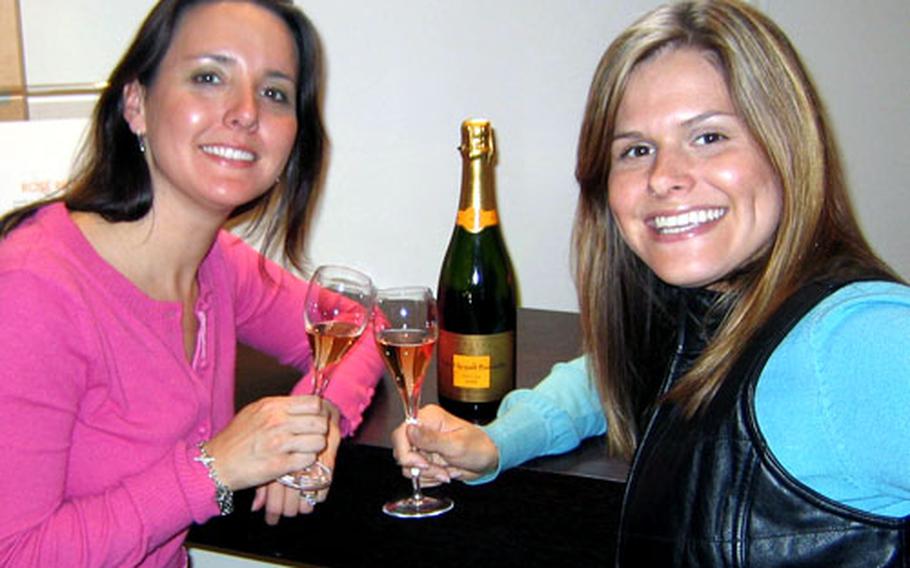
Britt Warden, left, and her sister Sarah sample champagne after taking the tour at the Veuve Clicquot Champagne house in Reims, France. (Steve Mraz / S&S)
About a 2½-hour drive fromGermany through the rolling French countryside is the only place in the world that canproduce the king of drinks and the drink of kings — champagne.
A trip to the Champagne region offers a chance to sip bubbly and explore the chalky hillsides that give birth to the grapes that make champagne. The sparkling wine produced there is one of the most tightly controlled in France. Vineyards are classified, the type of grapes grown are limited, the amount of juice from each pressing is controlled and the age at which the wine can be sold is regulated.
The region is anchored by the city of Reims, which also houses an impressive cathedral, and the town of Épernay, south of Reims.
Driving to Reims from Germany is fairly easy as the route there keeps you on superhighways. (Take about 20 euros for tolls and remember there is a speed limit on French highways.) In Reims, you can visit such swanky champagne houses — the places where champagne is produced — as Veuve Clicquot (visit Web site or call for required reservations), Taittinger, Mumm, Pommery and Piper-Heidsieck to name a few. Keep in mind that most houses are closed from around noon to 2 p.m.
On the tours, which start at around 7 euros, visitors go into the cellars, learn how the wine is made and are served a glass of champagne for tasting. At Piper-Heidsieck, visitors wind through the caves on a Disney World-like narrated ride, which is little hokey but entertaining.
You can also pay a little extra at all the houses to taste different styles of champagne. Bubbly’s not all that cheap, so it can get a little pricey depending on how thirsty you are. Each house has a boutique that sells apparel, merchandise and champagne.
Reims also has a pedestrian street that is lined with restaurants and supported by an underground parking garage. On the street, Place Drouet d’Erlon, you can have an authentic French dining experience at Brasserie Flo or grab a cheap döner at one of the several kebap counters.
From Reims, it’s about a 30-minute drive south to Épernay, which bills itself as the capital of the Champagne region. Épernay is surrounded by vineyards and truly feels like the heart of the region. Once there, you can visit dozens of champagne houses. The most notable is Moët & Chandon, where the famous Dom Perignon champagne is made. A statue of the late monk, who is often credited with inventing champagne, stands inside the house’s gates on Avenue de Champagne.
For a scenic drive, get lost on the Route Touristique de Champagne out of Épernay. A free map of the route is available at the city tourist office, which is diagonally across the street from Moët & Chandon. The route takes you through tiny villages and vineyards where the three types of grapes needed to make champagne are grown. Several small champagne houses are placed along the route if you need to make a pit stop.
If sampling, be sure to drink responsibly and have a designated driver for your trip. Then you can uncork an adventure in the Champagne region, taste the drink of kings and toast to the good life.
On the QTDIRECTIONS: From Kaiserslautern, take Autobahn 6 toward Saarbrück- en. As you near Saarbrücken, follow signs toward Paris as A6 becomes A32 as it enters France. Follow that toward St. Avold/ Metz-Paris, then merge on to A4/Autoroute de l’Est (portions require toll). Take Exit 23 toward Reims-Centre. To reach Épernay, take N51 south from Reims.
TIMES: In the spring and summer, champagne houses are open daily; in fall and winter, they are open Monday through Friday. Most open around 9 a.m., close around noon and reopen from 2 to 5 p.m. Times vary, so check Web sites for details.
COSTS: Champagne tasting tours start at around 7 euros. Bottles of champagne begin at about 20 euros a bottle.
FOOD: There are several restaurants on Place Drouet d’Erlon in Reims to choose from. Check posted menus.
INFORMATION: The champagne caves are chilly and wet in some areas, so it’s a good idea to have a decent pair of shoes and a light jacket or sweater, even in the summer. For details about individual houses, see their Web sites:
In Reims: www.veuve-clicquot.com; www.pommery.com; www.mumm.com; www.taittinger.com; www.piper-heidsieck.comIn Épernay: www.moet.com; www.castellane.comFor details on the cities, see www.ville-reims.com or www.epernay.net.
— Steve Mraz